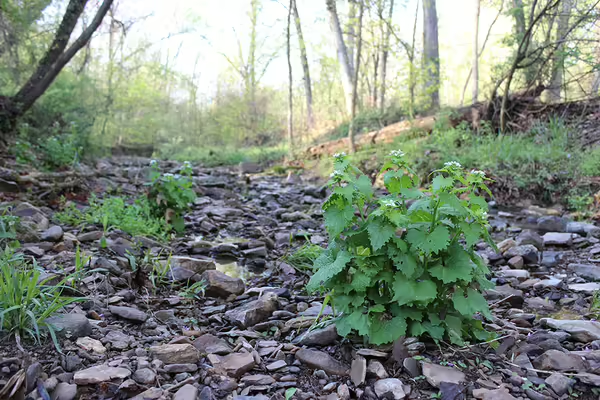
URBANA, Ill. – Every spring, early blooming ephemeral flowers are a welcome sign from nature that winter is almost over. But Virginia bluebells, mayapples, spring beauties, and other native plants are fighting invasive species for a place in Illinois forests.
Forest owners, land managers, and natural area visitors can help. Now is the time to scout for and remove garlic mustard.
“Garlic mustard is a high-priority invasive species for Illinois,” says Christopher Evans, Research and Forest Specialist with University of Illinois Extension. “Large infestations limit the growth and productivity of native plants and threaten the long-term health of forests.”
Garlic mustard’s early spring growth can quickly take over the forest understory becoming a monoculture in a few years. Infestations take away light, water, and nutrients from native plants, which threatens the insects and wildlife that rely on them. Large populations reduce our ability to enjoy wildflowers, watch birds, harvest timber, hunt, and spend time in beautiful, healthy forests now and in the future.
“The best way to manage garlic mustard is to keep it out of your forest,” Evans says. “Large infestations take a lot of time and effort to control but catching plants before they spread is the easiest way to keep your forest healthy.”
Prevention methods include cleaning boots, tires, and horse hooves to remove seeds after visiting an area. Monitor for garlic mustard plants every spring along forest edges, creeks, trails, and in disturbed areas. Mark the location with a flag or mapping app to relocate it later. Landowners can discuss their concerns about invasives with neighbors and plan to work together to manage them.
Garlic mustard plants are easiest to identify and remove when they flower, which starts in late February downstate and in mid-April in Northern Illinois. The flowering stalk is 1-to-4 feet tall with triangular, toothed-edged leaves and its small flowers have four white petals. Those visiting recreational nature areas should report sightings to staff and with the EDDMaps app or online at www.eddmaps.org.
For those who have garlic mustard, Evans says there is a 6- to 8-week window in spring to remove plants before they produce seeds and spread further. Removing garlic mustard is a multi-year process and control options include mowing, cutting, hand pulling, prescribed burns, and herbicides. Consult with an Extension educator before starting to develop a strategic plan.
Get help with garlic mustard identification, explore removal options, and consult with an Extension educator at go.illinois.edu/GarlicMustard.
30-SECOND PSA: As you're exploring forests this spring, keep an eye out for the invasive species garlic mustard. This aggressive plant can quickly take over woodlands harming native plants and wildlife and should be removed. Large infestations mean we can't enjoy wildflowers, watch birds, harvest timber, hunt, and spend time in beautiful, healthy forests. Get help with plant identification, explore removal options, and consult with a University of Illinois Extension educator at go.illinois.edu/GarlicMustard.
ABOUT EXTENSION: Illinois Extension leads public outreach for University of Illinois by translating research into action plans that allow Illinois families, businesses, and community leaders to solve problems, make informed decisions, and adapt to changes and opportunities.
PHOTO ACCESS: The photo in this article is available to download for media use.